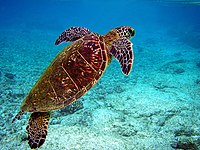
Photo from wikipedia
Abstract Anthropogenic climate change is widely considered a major threat to global biodiversity, such that the ability of a species to adapt will determine its likelihood of survival. Egg‐burying reptiles… Click to show full abstract
Abstract Anthropogenic climate change is widely considered a major threat to global biodiversity, such that the ability of a species to adapt will determine its likelihood of survival. Egg‐burying reptiles that exhibit temperature‐dependent sex determination, such as critically endangered hawksbill turtles (Eretmochelys imbricata), are particularly vulnerable to changes in thermal regimes because nest temperatures affect offspring sex, fitness, and survival. It is unclear whether hawksbills possess sufficient behavioral plasticity of nesting traits (i.e., redistribution of nesting range, shift in nesting phenology, changes in nest‐site selection, and adjustment of nest depth) to persist within their climatic niche or whether accelerated changes in thermal conditions of nesting beaches will outpace phenotypic adaption and require human intervention. For these reasons, we estimated sex ratios and physical condition of hatchling hawksbills under natural and manipulated conditions and generated and analyzed thermal profiles of hawksbill nest environments within highly threatened mangrove ecosystems at Bahía de Jiquilisco, El Salvador, and Estero Padre Ramos, Nicaragua. Hawksbill clutches protected in situ at both sites incubated at higher temperatures, yielded lower hatching success, produced a higher percentage of female hatchlings, and produced less fit offspring than clutches relocated to hatcheries. We detected cooler sand temperatures in woody vegetation (i.e., coastal forest and small‐scale plantations of fruit trees) and hatcheries than in other monitored nest environments, with higher temperatures at the deeper depth. Our findings indicate that mangrove ecosystems present a number of biophysical (e.g., insular nesting beaches and shallow water table) and human‐induced (e.g., physical barriers and deforestation) constraints that, when coupled with the unique life history of hawksbills in this region, may limit behavioral compensatory responses by the species to projected temperature increases at nesting beaches. We contend that egg relocation can contribute significantly to recovery efforts in a changing climate under appropriate circumstances.
Journal Title: Ecology and Evolution
Year Published: 2019
Link to full text (if available)
Share on Social Media: Sign Up to like & get
recommendations!